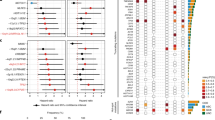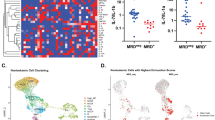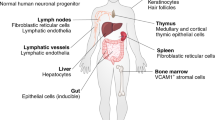Abstract
We previously reported a strong IL4I1 gene expression in primary mediastinal B-cell lymphoma (PMBL) and recently identified the protein as a secreted L-phenylalanine oxidase, physiologically expressed by myeloid cells, which inhibits T-cell proliferation in vitro. Here, we analyzed the pattern of IL4I1 protein expression in 315 human lymphoid and non-lymphoid malignancies. Besides PMBL, IL4I1 expression in tumors was very frequent. IL4I1 was detected in tumor-associated macrophages from most of the tumors and in neoplastic cells from follicular lymphoma, classic and nodular lymphocyte predominant Hodgkin lymphomas and small lymphocytic lymphoma, three of which are germinal center derived. IL4I1-positive tumor cells were also detected in rare cases of solid cancers, mainly mesothelioma. The enzymatic activity paralleled protein expression, suggesting that IL4I1 is functional in vivo. Depending on the tumor type, IL4I1 may impact on different infiltrating lymphocyte populations with consequences on tumor evolution. In the particular case of follicular lymphoma cells, which are susceptible to antitumor cytotoxic T cells killing but depend on interactions with local T helper cells for survival, a high level of IL4I1 expression seems associated with the absence of bone marrow involvement and a better outcome. These findings plead for an evaluation of IL4I1 as a prognosis factor.
This is a preview of subscription content, access via your institution
Access options
Subscribe to this journal
Receive 12 print issues and online access
$259.00 per year
only $21.58 per issue
Buy this article
- Purchase on Springer Link
- Instant access to full article PDF
Prices may be subject to local taxes which are calculated during checkout




Similar content being viewed by others
References
Copie-Bergman C, Boulland ML, Dehoulle C, Moller P, Farcet JP, Dyer MJ et al. Interleukin 4-induced gene 1 is activated in primary mediastinal large B-cell lymphoma. Blood 2003; 101: 2756–2761.
Boulland ML, Marquet J, Molinier-Frenkel V, Moller P, Guiter C, Lasoudris F et al. Human IL4I1 is a secreted L-phenylalanine oxidase expressed by mature dendritic cells that inhibits T-lymphocyte proliferation. Blood 2007; 110: 220–227.
Bronte V, Zanovello P . Regulation of immune responses by L-arginine metabolism. Nat Rev Immunol 2005; 5: 641–654.
Marigo I, Dolcetti L, Serafini P, Zanovello P, Bronte V . Tumor-induced tolerance and immune suppression by myeloid derived suppressor cells. Immunol Rev 2008; 222: 162–179.
Rabinovich GA, Gabrilovich D, Sotomayor EM . Immunosuppressive strategies that are mediated by tumor cells. Annu Rev Immunol 2007; 25: 267–296.
Sawanobori Y, Ueha S, Kurachi M, Shimaoka T, Talmadge JE, Abe J et al. Chemokine-mediated rapid turnover of myeloid-derived suppressor cells in tumor-bearing mice. Blood 2008; 111: 5457–5466.
Bingle L, Brown NJ, Lewis CE . The role of tumour-associated macrophages in tumour progression: implications for new anticancer therapies. J Pathol 2002; 196: 254–265.
Canioni D, Salles G, Mounier N, Brousse N, Keuppens M, Morchhauser F et al. High numbers of tumor-associated macrophages have an adverse prognostic value that can be circumvented by rituximab in patients with follicular lymphoma enrolled onto the GELA-GOELAMS FL-2000 trial. J Clin Oncol 2008; 26: 440–446.
Lewis CE, Pollard JW . Distinct role of macrophages in different tumor microenvironments. Cancer Res 2006; 66: 605–612.
Movahedi K, Guilliams M, Van den Bossche J, Van den Bergh R, Gysemans C, Beschin A et al. Identification of discrete tumor-induced myeloid-derived suppressor cell subpopulations with distinct T cell-suppressive activity. Blood 2008; 111: 4233–4244.
Uyttenhove C, Pilotte L, Theate I, Stroobant V, Colau D, Parmentier N et al. Evidence for a tumoral immune resistance mechanism based on tryptophan degradation by indoleamine 2,3-dioxygenase. Nat Med 2003; 9: 1269–1274.
Metz R, Duhadaway JB, Kamasani U, Laury-Kleintop L, Muller AJ, Prendergast GC . Novel tryptophan catabolic enzyme IDO2 is the preferred biochemical target of the antitumor indoleamine 2,3-dioxygenase inhibitory compound D-1-methyl-tryptophan. Cancer Res 2007; 67: 7082–7087.
Ma Y, Visser L, Roelofsen H, de Vries M, Diepstra A, van Imhoff G et al. Proteomics analysis of Hodgkin lymphoma: identification of new players involved in the cross-talk between HRS cells and infiltrating lymphocytes. Blood 2008; 111: 2339–2346.
Fong CJ, Burgoon LD, Williams KJ, Forgacs AL, Zacharewski TR . Comparative temporal and dose-dependent morphological and transcriptional uterine effects elicited by tamoxifen and ethynylestradiol in immature, ovariectomized mice. BMC Genomics 2007; 8: 151.
Poppema S . Immunobiology and pathophysiology of hodgkin lymphomas. Hematology Am Soc Hematol Educ Program 2005, 231–238.
Marshall NA, Christie LE, Munro LR, Culligan DJ, Johnston PW, Barker RN et al. Immunosuppressive regulatory T cells are abundant in the reactive lymphocytes of Hodgkin lymphoma. Blood 2004; 103: 1755–1762.
Copie-Bergman C, Gaulard P, Maouche-Chretien L, Briere J, Haioun C, Alonso MA et al. The MAL gene is expressed in primary mediastinal large B-cell lymphoma. Blood 1999; 94: 3567–3575.
Schroder AJ, Pavlidis P, Arimura A, Capece D, Rothman PB . Cutting edge: STAT6 serves as a positive and negative regulator of gene expression in IL-4-stimulated B lymphocytes. J Immunol 2002; 168: 996–1000.
Skinnider BF, Elia AJ, Gascoyne RD, Patterson B, Trumper L, Kapp U et al. Signal transducer and activator of transcription 6 is frequently activated in Hodgkin and Reed-Sternberg cells of Hodgkin lymphoma. Blood 2002; 99: 618–626.
Guiter C, Dusanter-Fourt I, Copie-Bergman C, Boulland ML, Le Gouvello S, Gaulard P et al. Constitutive STAT6 activation in primary mediastinal large B-cell lymphoma. Blood 2004; 104: 543–549.
Calvo KR, Dabir B, Kovach A, Devor C, Bandle R, Bond A et al. IL-4 protein expression and basal activation of Erk in vivo in follicular lymphoma. Blood 2008; 112: 3818–3826.
Rosenwald A, Wright G, Leroy K, Yu X, Gaulard P, Gascoyne RD et al. Molecular diagnosis of primary mediastinal B cell lymphoma identifies a clinically favorable subgroup of diffuse large B cell lymphoma related to Hodgkin lymphoma. J Exp Med 2003; 198: 851–862.
Yu D, Cozma D, Park A, Thomas-Tikhonenko A . Functional validation of genes implicated in lymphomagenesis: an in vivo selection assay using a Myc-induced B-cell tumor. Ann NY Acad Sci 2005; 1059: 145–159.
Ghia EM, Jain S, Widhopf II GF, Rassenti LZ, Keating MJ, Wierda WG et al. Use of IGHV3-21 in chronic lymphocytic leukemia is associated with high-risk disease and reflects antigen-driven, post-germinal center leukemogenic selection. Blood 2008; 111: 5101–5108.
Finak G, Bertos N, Pepin F, Sadekova S, Souleimanova M, Zhao H et al. Stromal gene expression predicts clinical outcome in breast cancer. Nat Med 2008; 14: 518–527.
Roulland S, Suarez F, Hermine O, Nadel B . Pathophysiological aspects of memory B-cell development. Trends Immunol 2008; 29: 25–33.
Acknowledgements
This work was supported by ARC subvention fixe 4883 to FC. We are indebted to Willam Hempel for critical reading and English editing of the article. We thank the Plateforme de ressources biologiques of Henri Mondor Hospital, Dr Françoise Lange, Dr Jeanne Tran Van Nhieu and Dr Annabelle Werbrouck for providing precious human samples. We are also grateful to Jeanine Marquet, Rita Colognon, Céline Cousin, Antoine Allain and Marie-Claude Bassène for technical assistance and to all the clinicians from the Unité Hémopathies Lymphoïdes of CHU Mondor-Chenevier. We are indebted to the association for therapeutic, genetic and immunologic research on lymphoma (ARTGIL) for providing financial support to MB.
Author information
Authors and Affiliations
Corresponding authors
Rights and permissions
About this article
Cite this article
Carbonnelle-Puscian, A., Copie-Bergman, C., Baia, M. et al. The novel immunosuppressive enzyme IL4I1 is expressed by neoplastic cells of several B-cell lymphomas and by tumor-associated macrophages. Leukemia 23, 952–960 (2009). https://doi.org/10.1038/leu.2008.380
Received:
Revised:
Accepted:
Published:
Issue Date:
DOI: https://doi.org/10.1038/leu.2008.380
Keywords
This article is cited by
-
IL4I1 enhances PD-L1 expression through JAK/STAT signaling pathway in lung adenocarcinoma
Immunogenetics (2023)
-
N6-methyladenosine-related lncRNAs identified as potential biomarkers for predicting the overall survival of Asian gastric cancer patients
BMC Cancer (2022)
-
A balanced game: chicken macrophage response to ALV-J infection
Veterinary Research (2019)
-
A high number of IgG4-positive plasma cells rules out nodular lymphocyte predominant Hodgkin lymphoma
Virchows Archiv (2018)
-
Alterations of the immunosuppressive IL4I1 enzyme activity induced by naturally occurring SNP/mutations
Genes & Immunity (2016)



